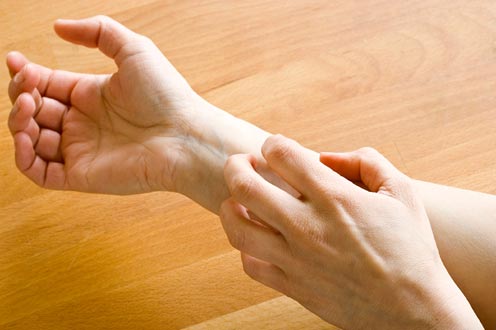Eczema is a blanket term used to describe a plethora of dry, skin conditions, characterized by irritated skin and inflammation. A common denominator to the eczema equation, is an incessant itch, that begs you to scratch it. Below are seven helpful tips for not scratching that itch:
1. Trim Those Nails
Keeping your nails short, will help you to not tear your flesh, if you should scratch. While not scratching is the optimal solution, there are times when it will occur. These times can occur unconsciously. For example, during times you are asleep. If you have a child with eczema, keeping nails trimmed and clean is especially important. How many times do you tell your child not to do something, only to witness them ignore that instruction? Exactly! It is very important they don’t scratch, but because they likely will, trim those nails!
2. Take a Bleach Bath
Sounds crazy, right? Bleach baths have been attributed to relieving the eczema itch factor, as well as drying out infection that can be associated with it. They are acknowledged as an effective form of treatment by the American Academy of Dermatology (AAD). Of course, do not implement this measure of care without taking the necessary precautions: never pour bleach directly on the skin, measure with precision, pour the bleach into the bath while water is running, and never get into the tub until it is done running.

Bleach to Water Ratios
- For a 1/4 full “normal sized” tub, add 1/8 cup of bleach.
- For a 1/2 full tub, add 1/4 cup of bleach.
- For a 3/4 full tub, add 3/8 cup of bleach.
3. Increase your Omega-3 Intake
Omega-3 fatty acids contain anti-inflammatory properties. Because eczema is characterized by inflammation, it is believed that a diet that incorporates omega-3’s into it, will experience a benefit with inflammation reduction. There are several foods that contain omega-3’s including: albacore white tuna, mackerel, sardines, avocado, walnuts, salmon and flaxseed. Flaxseed can be taken in oil form or in natural form; however, it is most beneficial when grinded fresh daily. A wonderful place to hide that flaxseed is ground up in some delicious yogurt. The yogurt will give you an added kick of probiotics to boot!
4. Cool the Affected Area
Use cold compresses to numb the affected area. You can use an ice pack, as well. However, do not apply ice directly to the skin, as it can result in freezer burn. Wrap it in a thin washcloth or hand towel to prevent this. Leave the compress on the affected area for 15-20 minutes. Once the area is numb, the itch will subside.
5. Moisturize Your Skin
Lastly, moisturizing is critical for combating that unwanted itch. The dryer or more infected the skin, the worse it will itch. The best skin care products for proper moisturizing, will contain ceramides. Ceramides are an essential skin lipid that makes up around 47% of the epidermis (top layer of skin). They are lost due to environmental factors, aging and skin damage. It is important to replenish them. While most products will encourage you to moisturize, twice daily, I encourage a four times per day regimen. Especially, while skin is actively dry, itchy or irritated with eczema flare ups.
Dr. Cheryl Lee Eberting is a board certified dermatologist who has dedicated her career to research and treatment of skin ailments. She blogs regularly at cherylleemd.com










Comments are closed.